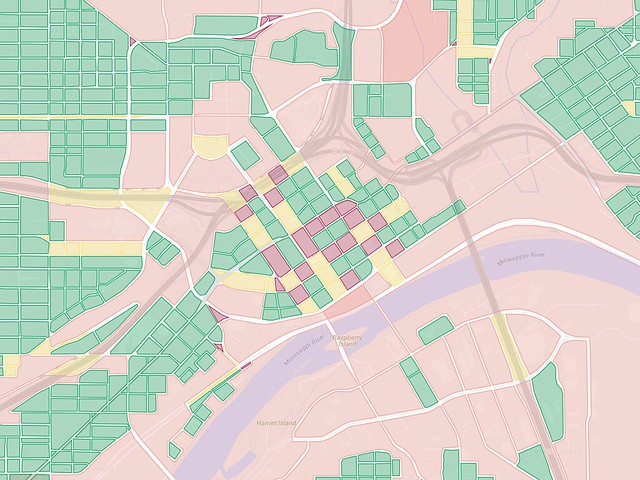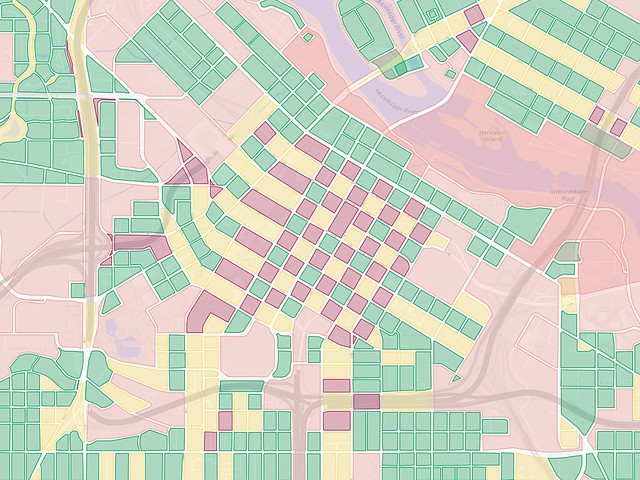
Map of city blocks in downtown Saint Paul. Click here for full map.
How hard is it to get around the city block where you live, work, or shop? Does that affect the modes of transportation you choose on a daily basis? Does it impact the choices of city planners, or the areas where businesses choose to locate?
Until I started working in downtown Saint Paul, I often avoided the area due to its reputation for getting people lost. There are several one-way streets that create confusion, and the north-south streets are mostly named rather than numbered, so it becomes difficult to keep track of where you are unless you know the pattern. Take a wrong turn, and a driver can inadvertently get sent across one of the long bridges that separate downtown from other neighborhoods.
The streets aren't just an issue for drivers, though. Cyclists are also supposed to ride on the street and take the same circuitous paths as cars (unless you cheat by riding on the sidewalk). Even walking is impacted—I often use the green traffic light as a backup for knowing when to cross, since many pedestrian signals don't activate automatically, but car car signals aren't visible on some corners of one-way intersections.
Recently, I started mapping downtown to try and represent these navigation difficulties, starting with how hard it is to turn where and when you want to. I used green for blocks that can be circled in a clockwise direction with right-hand turns when driving. Yellow blocks mean that one-way streets on at least one side require turning left to make it all the way around. I used dark red for blocks where at least one turn would send you into oncoming traffic—those blocks require you to include at least one other block when circling around.
However, a different pattern began to dominate as I moved away from downtown and into the nearby neighborhoods. "Big" city blocks also create an impediment to navigating the city. The most obvious boundary around downtown is the Mississippi River, but there are highways, railways, and other underdeveloped spaces that almost completely isolate downtown from other neighborhoods. I used a threshold of 15 acres to distinguish "big" blocks (shown in pink) vs. "small" blocks—a number I arrived at for little more reason than 10 acres seemed too low and 20 acres seemed too high.
A square block of 15 acres has a circumference of about 0.6 miles, taking about 12 minutes to walk around, and the time and distance increases as blocks become more rectangular or otherwise elongated. Of course, some smaller blocks can take much longer than 12 minutes to circle on foot due to strange shapes, and the presence of small blocks doesn't automatically mean that you're in a walker's paradise. But in general, I think the resulting maps give a good indication of what it's like to get around.
Compare the above map of downtown Saint Paul with another one I made of downtown Minneapolis. This shows a fantastic checkerboard pattern of blocks that can be circled clockwise, counterclockwise, and the ones that have turn conflicts requiring extra circling of adjacent blocks.

Map of city blocks in downtown Minneapolis. Click here for full map.
Both downtowns have significant "moats" around them, though downtown Minneapolis retains more connections to nearby neighborhoods, especially to the south. In both cities, highways (especially interchanges) make large unwalkable zones, though the straighter mainline sections of the highways aren't quite as bad. Saint Paul significantly tore down a large amount of housing in the West Side Flats area in the early 1960s, and the city's Port Authority redeveloped it as a low-density industrial park. Large areas were also torn down to free up room for the capitol grounds. The park-like capitol lawn is an impressive space, but opening up the area in that way created something more similar to a suburban office park than a downtown zone.
Saint Paul is also much more heavily affected by railroads than Minneapolis is today. Both cities used to have a lot of railroad activity downtown, but only one freight rail corridor still cuts through the center of Minneapolis today, in the Warehouse District on the edge of downtown. On the other hand, Saint Paul sits at the a convergence point of six or seven different railroad lines operated by three different freight companies, including two major transcontinental rail corridors. In the heyday of passenger rail, this was good since it allowed lines to branch out in any direction, but with passenger service almost completely wiped out today, the freight lines present a significant burden on the downtown area.
This map likely helps explain how the West 7th Street neighborhood is one of the most active areas in/near downtown, since it's one of the only continuous connections of smaller, more walkable blocks leading into downtown. The only other similar link is along Robert Street and Jackson Street on the north end of the city—an area dominated by government buildings and a hospital.
Downtown Minneapolis blends into nearby neighborhoods more readily, though there are still significant gaps. I skipped over freeways when making these maps, since it's illegal to walk or bike along them except in limited circumstances, but also avoided routes that are only for bikes or pedestrians. That's mostly just to keep the maps relatively simple—many bike and pedestrian connections are hard to see on maps, and they more frequently involve bridges, which lead to some trouble when mapping. Sometimes a single spot can be encircled by several different "blocks" depending on which bridges or other links you choose to use—I've included some of those, such as on Nicollet Island in Minneapolis, but tried to limit my use of overlapping blocks to keep the maps cleaner.
What stands out to you about these maps? Do they match the way you feel about the ease or difficulty of getting around these parts of town?
No comments:
Post a Comment